The Vietnamese cuisine is one of the best and finest of Asia. Both cheap and exotic, it is not very spicy in the North. However, you will be generally offered side sauces that can turn out to be pretty spicy! Cooking is my passion, and in order to discover it…follow the links!
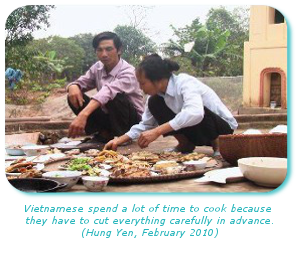
The cuisine can turn out to be quite different depending on the area you are at:
In the North, the cuisine is mostly based on meat maceration in skillfully elaborated sauces;
In the Center, the cuisine is inspired from the imperial dishes of Hue. It is enhanced with black pepper, red chili, garlic and lemongrass;
In the South, the dishes are spicier and sweeter. Denominations of similar dishes can sometimes be different from one region to the other, in Saigon the nem is called ‘’imperial egg roll’’…
Where to eat?
What could be easier than to find a place to eat in Viet Nam? From big fancy restaurants to the street vendors and not to forget the ‘’pavement restaurants’’ and the bia hoi where you are sit on plastic ‘’mini stools’’, you could only discover the culinary richness of the ‘’500 recipes’’ Country!
When to eat?
Whether in the morning, noon or evening, the Vietnamese people eat early: between 6 and 8 in the morning for breakfast, between 11 and noon for lunch and before 7.30pm for diner. Outside theses hours, it can be difficult for you to find what you are looking for, especially in much-less touristy areas…but in town you can find street restaurants serving single dish open 24/7.
A traditional meal without rice liquor is not a complete meal. In this way, maybe will you get the chance to taste the popular ruou ([ziô]) that, unlike the Japanese sake, can be served throughout the whole meal and not just at the end. However, be careful with its 35 to 45 degrees of alcohol or else the nap could be near…
Rice, soup, instant noodles and…sandwiches!
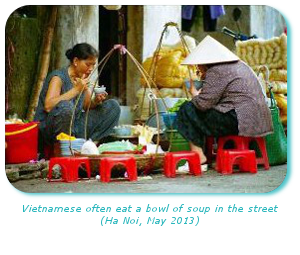
The rice (com – [keum]) is the very basis of nutrition in Viet Nam. It can be served white or fried, plain or served with vegetables soup, meat, seafood or vegetables.
At any time, you would be able to savor Vietnamese soups (pho – [fœ]), made of rice noodles (bun – [bougn]) or of vermicelli (mien – [mien]), with aromatic herbs – coriander, mint, dill, fennel, basil, star anise… - and with meat – beef, buffalo, pork, duck or chicken.
Just like the rice, the instant egg noodles (my xao tôm– [mi sao tom]) are served fried with vegetables, seafood or meat.
The sandwiches, called banh my ([ban mi]) in Viet Nam, are French breads and not sandwich loaves. Street vendors sell them at intersections or in small shops, and ask you what them to put inside. They are generally served hot with eggs, pâté, vegetables… They are the real backpacker’s snacks!
The sauces
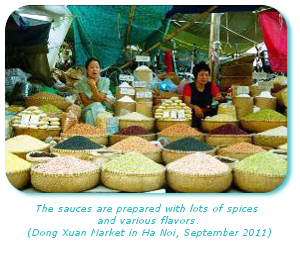
The Vietnamese cuisine would not be as exceptional without its sauces. The two most famous ones are the nuoc mam, a sauce fermented from 4 to 12 months with very salty fishes in ceramic bowls, and the soja sauce, a very dark sauce and way sweeter than the nuoc mam.
Each dish is served with its own sauce. That is the reason why a Vietnamese buffet looks impressive by its number of dishes and cups present on the table! Other sauces exist such as green lemon, chili and salt based sauces. However, the curious minds could also try the mam tôm; a spicy mix of fermented shrimps which purplish color and a foul smell which hardly seduces the tourists. The mam tôm is traditionally served with dog meat and cha ca.
The meats (thit [tit])
Traditionally, the meats eaten in Viet Nam are the following, beef: thit bo, buffalo: thit trau, pork: thit lon, chicken: thit ga, duck: thit vit and other ‘’exotic’’ meats: dog: thit cho, snake: thit ran, cat: thit meo, rabbit: thit tho, goat: thit dê, frog: êch, escargots: ôc.
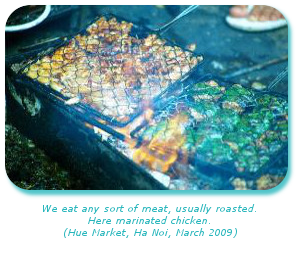
Despite the avian flu, we particularly appreciate chicken and duck meat in Viet Nam. Pork constitutes the everyday life meat. Beef is also much appreciated even if its price is a lot higher. Only the ‘’exotic’’ meats are less used, either because they are poorly appreciated or because a consumption tradition exists according to the lunar calendar (in the case of dog meat for example).
The meat can be served in different ways: boiled, grilled, fried…but it can also be served cut into thin slices or into slightly thicker pieces. However, it is still very rare to order an actual ‘’steak’’!
Concerning poultry and small animals (rabbits, cats…), the meat cut is not necessarily what you are usually used to. As we love all games based on savors discoveries, especially through spices, the Vietnamese people also seek different textures for their dishes. In this way, it is not uncommon for some dishes not to separate the meat from its bones…for a rather crunchier touch!
Fish and seafood (ca, tôm, muc…)
In the gulf of Tonkin, as well as in the Mekong Delta or on the coastlines of the Middle part of the country, numerous dishes based on fish and seafood are on the menu. The famous cha ca, a Ha Noi specialty is for example an excellent dish based on fried fish and aromatic herbs (coriander, anise…).
The fish on the menu is always fresh…but not always available! You can enjoy gambas, shrimps, clams and other squids! To be tasted without moderation…
Vegetables (rau [zao])
Different sorts of vegetables are available in Viet Nam, from the most commons (eggplants, carrots, mushrooms, cabbages, cucumber, corn, sweet potatoes, peppers, potatoes, tomatoes) to the totally unknown ones for tourists.
We are accustomed, for example, to eat great quantities of leaves and stems either boiled or fried. Some of them are aquatic such as water bindweeds (rau mong), others are known plants leaves, such as pumpkin leaves (rau bi) or sweet potato leaves (rau lang).
Fruits
Freshly bought from the market, fruits are truly delightful in Viet Nam. Each season introduces its share of aromas:
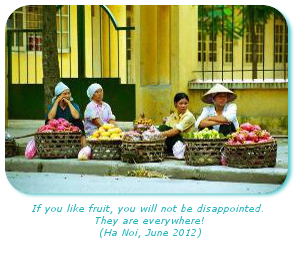
The most flavored ones: litchis, mangos, oranges, jackfruits, passion fruits
The most thirst-quenching ones: dragon fruits, watermelons, coconuts
The less known ones: apple-cinnamon, mangosteens, pomegranates, longans
The ‘’odd’’ ones: durians, papayas
The most common ones: grapes, peaches, apples, avocados, pineapples, bananas, grapefruits
Desserts
Desserts are not very common in Viet Nam. Fruits often replace your usual pastry and cream. The three most eaten desserts here are: chè, traditional cakes (banh com, banh su) and some ice creams (kem).
Beverages
The most consumed beverage in the country is tea (tra). We drink it at any time of the day, in the city and in the countryside as well, it can be served hot, cold or iced. Most of the time it is green tea, but other aromatic teas begin to be introduced successfully as well.
The second most popular beverage is beer (bia), and more particularly draught beer (bia hoi). Tradition has it that around 5.30pm, after working hours, men gather in those local pubs (generally on the pavement) to order that famous, light in alcohol, cheap and widespread beverage.
Then, we also have the Nuoc Qua (fruit juices) and Sinh To (a sort of smoothie/milk-shake). They are fresh fruits based juices puree until smooth, to which we add some fresh milk, condensed milk, sugar or even a little of coconut milk. The result is dazzling…and extremely healthy!
Coffee can be either in lyophilized doses or fresh. It is served in a cup topped by an aluminum filter. Extremely strong and condensed, one of those little coffees generally wakes you up for a long time!
One cannot talk about beverages without mentioning the rice alcohol (ruou). It exists about ten different sorts of ruou, from the tasteless industrial at 45° ones to the very local ones, not necessarily strong but very fruity. The sticky rice alcohol (Ruou Nep) is particularly tasty. In restaurants, you could also find rice alcohol presented in jars with marinated snakes, bees, roots and herbs, each jar of alcohol represents a particular taste.





